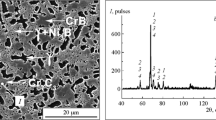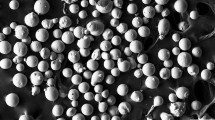Abstract
Laser cladding, which is characterized by the minimal thermal impact on the substrate, is an advanced technique to restore the working dimensions of parts subject to wear. The Ni–Cr–B–Si system coatings can be used for parts operating at high temperatures. Our work aims at studying the effect of heating and subsequent cooling conditions in the process of high-temperature treatment on the features of the structural and phase state of the coating obtained by laser cladding of the PG-SR2 powder (chemical composition, wt %: 14.8 Cr, 2.1 B, 2.9 Si, 2.6 Fe, and 0.48 S; the rest is Ni) and the properties obtained as a result of this treatment (hardness and tribological characteristics in sliding on fixed abrasive corundum). Samples with a laser-clad layer were heated at a temperature of 1050°C (holding for 1 h) and subsequently cooled in water (which made it possible to record structural transformations under high-temperature heating), in air, and in a muffle and a vacuum furnace. It has been shown that the rate of cooling during the high-temperature treatment of the laser-clad PG-SR2 coating significantly affects the structure and properties. High-temperature heating leads to partial diffusive dissolution of nickel borides (Ni3B) and chromium carbides (Cr23C6) in a solid solution and a corresponding decrease in hardness and an increase in the abrasive wear intensity and the coefficient of friction. The reduction in the rate of cooling from 1050°C of the samples in air, a muffle furnace, or a vacuum furnace leads to the precipitation of chromium borides (CrB) and nickel silicide (Ni3Si), which were absent in the clad coating structure. High-strength CrB borides whose hardness is equal to or even exceeds that corundum abrasive hinder the development of the microcutting mechanism in the process of abrasive wear. Coarse chromium carbides and borides formed in the process of slow cooling in the furnace form wear-resistant framelike structures. This results in an increase in hardness and abrasive wear resistance to the values that exceed those of the original clad coating.





Similar content being viewed by others
REFERENCES
Kiryukhantsev-Korneev, Ph.V., Sytchenko, A.D., and Levashov, E.A., Comparative study of coatings formed by electrospark alloying using TiC–NiCr and TiC–NiCr–Eu2O3 electrodes, Russ. J. Non-Ferrous Met., 2019, vol. 60, pp. 1–11. https://doi.org/10.3103/S1067821219060099
Biryukov, V.P. and Bazlova, T.A., Experimental and computational determination of the wear resistant coefficient for coatings with nanodispersed carbide particles added by laser surfacing, Russ. J. Non-Ferrous Met., 2020, vol. 61, pp. 739–744. https://doi.org/10.3103/S1067821220060048
Pugacheva, N.B., Bykova, T.M., Trushina, E.B., and Malygina, I.Yu., The structural state and properties of a deposited coating for an internal combustion engine valve, Diagn., Resour. Mech. Mater. Struct., 2018, no. 5, pp. 74–85. https://doi.org/10.17804/2410-9908.2018.5.074-085
Biryukov, V.P., Wear of a laser-surfaced steel shaft and a slip-bearing bush, Russ. Eng. Res., 2015, vol. 35, pp. 249–252. https://doi.org/10.3103/S1068798X15040073
Gao, W., Chang, C., Li, G., Xue, Y., Wang, J., Zhang, Z., and Lin, X., Study on the laser cladding of FeCrNi coating, Optik, 2019, vol. 178, pp. 950–957. https://doi.org/10.1016/j.ijleo.2018.10.062
Frazier, W.E., Metal additive manufacturing: A review, J. Mater. Eng. Perform., 2014, vol. 23, pp. 1917–1928. https://doi.org/10.1007/s11665-014-0958-z
Muvvala, G., Patra Karmakar, D., and Nath, A.K., Online monitoring of thermo-cycles and its correlation with microstructure in laser cladding of nickel based super alloy, Opt. Laser Technol., 2017, vol. 88, pp. 139–152. https://doi.org/10.1016/j.optlaseng.2016.08.005
Loginova, I.S., Bykovskiy, D.P., Solonin, A.N., Prosviryakov, A.S., Cheverikin, V.V., Pozdniakov, A.V., and Petrovskiy, V.N., Peculiarities of the microstructure and properties of parts produced by the direct laser deposition of 316L steel powder, Russ. J. Non-Ferrous Met., 2019, vol. 60, pp. 87–94. https://doi.org/10.3103/S1067821219010085
Gómez-del Río, T., Garrido, M.A., Fernádez, J.E., Cadenas, M., and Rodriguez, J., Influence of the deposition techniques on the mechanical properties and microstructure of NiCrBSi coatings, J. Mater. Process. Technol., 2008, vol. 204, pp. 304–312. https://doi.org/10.1016/j.jmatprotec.2007.11.042
Fernández, E., Cadenas, M., González, R., Navas, C., Fernández, R., and Damborenea, J.D., Wear behavior of laser clad NiCrBSi coating, Wear, 2005, vol. 259, pp. 870–875. https://doi.org/10.1016/j.wear.2005.02.063
Pribytkov, G.A., Firsina, I.A., Korzhova, V.V., Krinitcyn, M.G., and Polyanskaya, A.A., Synthesis of TiC–NiCrBSi binder alloy composite powders for cladding and deposition of wear-resistant coatings, Russ. J. Non-Ferrous Met., 2019, vol. 60, pp. 282–289. https://doi.org/10.3103/S1067821219030118
Chen, L., Wang, H., Zhao, C., Lu, S., Wang, Z., Sha, J., Chen, S., and Zhang, L., Automatic remelting and enhanced mechanical performance of a plasma sprayed NiCrBSi coating, Surf. Coat. Technol., 2019, vol. 369, pp. 31–43. https://doi.org/10.1016/j.surfcoat.2019.04.052
Li, Q., Zhang, D., Lei, T., Chen, C., and Chen, W., Comparison of laser-clad and furnace-melted Ni-based alloy microstructures, Surf. Coat. Technol., 2001, vol. 137, pp. 122–135. https://doi.org/10.1016/S0257-8972(00)00732-5
Islak, S., Ulutan, M., and Buytoz, S., Microstructure and wear properties of hot-pressed NiCrBSi/TiC composite materials, Russ. J. Non-Ferrous Met., 2020, vol. 61, pp. 571–582. https://doi.org/10.3103/S1067821220050053
Navas, C., Colaco, R., Damborenea, J., and Vilar, R., Abrasive wear behavior of laser clad and flame sprayed-melted NiCrBSi coatings, Surf. Coat. Technol., 2006, vol. 200, pp. 6854–6862. https://doi.org/10.1016/j.surfcoat.2005.10.032
González, R., Cadenas, M., Fernández, R., Cortizo, J.L., and Rodriguez, E., Wear behaviour of flame sprayed NiCrBSi coating remelted by flame or by laser, Wear, 2007, vol. 262, pp. 301–307. https://doi.org/10.1016/j.wear.2006.05.009
Guo, Ch., Zhou, J., Chen, J., Zhao, J., Yu, Y., and Zhou, H., High temperature wear resistance of laser cladding NiCrBSi and NiCrBSi/WC-Ni composite coatings, Wear, 2011, vol. 270, pp. 492–498. https://doi.org/10.1016/j.wear.2011.01.003
Makarov, A.V., Soboleva, N.N., Malygina, I.Yu., and Osintseva, A.L., Formation of wear-resistant chromium-nickel coating with extra high thermal stability by combined laser-and-heat treatment, Met. Sci. Heat Treat., 2015, vol. 57, pp. 161–168. https://doi.org/10.1007/s11041-015-9856-8
Makarov, A.V., Soboleva, N.N., Malygina, I.Yu., and Kharanzhevskiy, E.V., Improving the properties of a rapidly crystallized NiCrBSi laser clad coating by high-temperature processing, J. Cryst. Growth, 2019, vol. 525, article no. 125200. https://doi.org/10.1016/j.jcrysgro.2019.125200
Savrai, R.A., Makarov, A.V., Soboleva, N.N., Malygina, I.Yu., and Osintseva, A.L., The behavior of gas powder laser clad NiCrBSi coatings under contact loading, J. Mater. Eng. Perform., 2016, vol. 25, pp. 1068–1075. https://doi.org/10.1007/s11665-016-1925-7
Makarov, A.V., Soboleva, N.N., and Malygina, I.Yu., Role of the strengthening phases in abrasive wear resistance of laser-clad NiCrBSi coatings, J. Frict. Wear, 2017, vol. 38, pp. 272–278. https://doi.org/10.3103/S1068366617040080
Lebaili, S., Durand-Charre, M., and Hamar-Thibault, S., The metallurgical structure of as-solidified Ni–Cr–B–Si–C hardfacing alloys, J. Mater. Sci., 1988, vol. 23, pp. 3603–3611. https://doi.org/10.1007/BF00540502
Kim, H.-J., Hwang, S.-Y., Lee, C.-H., and Juvanon, P., Assessment of wear performance of flame sprayed and fused Ni-based coatings, Surf. Coat. Technol., 2003, vol. 172, pp. 262–269. https://doi.org/10.1016/S0257-8972(03)00348-7
Gorunov, A.I. and Gilmutdinov, A.Kh., Study of the effect of heat treatment on the structure and properties of the specimens obtained by the method of direct metal deposition, Int. J. Adv. Manuf. Technol., 2016, vol. 86, pp. 2567–2574. https://doi.org/10.1007/s00170-016-8405-y
Khruschov, M.M., Principles of abrasive wear, Wear, 1974, vol. 28, pp. 69–88. https://doi.org/10.1016/0043-1648(74)90102-1
ACKNOWLEDGMENTS
These experiments were carried out using equipment of the Plastometriya shared-use center operated by the Institute of Engineering Science, Ural Branch, Russian Academy of Sciences. We thank I.Yu. Malygina for assistance in the experiments.
Funding
This study was supported by the Russian Science Foundation (grant 19-79-00031).
Author information
Authors and Affiliations
Corresponding authors
Ethics declarations
The authors declare that they have no conflict of interests.
Additional information
Translated by M. Shmatikov
About this article
Cite this article
Soboleva, N.N., Makarov, A.V. Effect of Conditions of High-Temperature Treatment on the Structure and Tribological Properties of Nickel-Based Laser-Clad Coating. Russ. J. Non-ferrous Metals 62, 682–691 (2021). https://doi.org/10.3103/S1067821221060183
Received:
Revised:
Accepted:
Published:
Issue Date:
DOI: https://doi.org/10.3103/S1067821221060183




